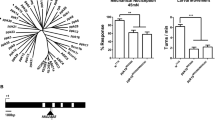Abstract
Studies are reported on a chemoreception mutant which arose in a mutator strain. The mutant sensory neurons do not stain with fluoresceine isothiocyanate (Dyf phenotype), hence the name,dyf-1, given to the gene it identifies. The gene maps on LGI, 0.4 map units fromdpy-5 on theunc-11 side. The response of mutant worms to various repellents has been studied and shown to be partially altered. Other chemoreception based behaviors are less affected. The cilia of the sensory neurons of the amphid are shorter than normal and the primary defect may be in the capacity of the sheath cells to secrete the matrix material that fills the space between cilia in the amphid channel. Progress toward the molecular cloning of the gene is also reported. Relevant results from other laboratories are briefly reviewed.
Similar content being viewed by others
References
Bargmann, C. I., E. Hartweig & R. H. Horvitz, 1993. Odorantselective genes and neurons mediate olfaction inC. elegans. Cell 74: 515–527.
Bargmann, C. I. & H. R. Horvitz, 1991a. Control of larval development by chemosensory neurons inCaenorhabditis elegans. Science 251: 1243–1246.
Bargmann, C. I. & H. R. Horvitz, 1991b. Chemosensory neurons with overlapping functions direct chemotaxis to multiple chemicals inC. elegans. Neuron 7: 729–742.
Bargmann, C. I., J. H. Thomas & H. R. Hortivz, 1990. Chemosensory cell function in the behavior and develpment ofCaenorhabditis elegans. Cold Spring Harbor Symp. Quant. Biol. LV: 529–538.
Bazzicalupo, P., L. De Riso, F. Ristoratore, F. Maimone & M. Sebastiano, 1994. Chemoreception in nematodes, in Advances in Molecular Plant Nematology, edited by C. De Giorgi, F. Lamberti and D. Bird. Plenum Press, New York, N.Y. In press.
Chalfie, M. & M. Au, 1989. Genetic control of differentiation of theCaenorhabditis elegans touch receptor neurons. Science 243: 1027–1033.
Chalfie, M. & J. G. White, 1988. The nervous system, pp. 337–391 in The NematodeCaenorhabditis elegans, edited by W. B. Wood, C. S. H. Press, Cold Spring Harbor, N.Y.
Culotti, J. & D. Russell, 1978. Osmotic avoidance defective mutants of the nematodeCaenorhabditis elegans. Genetics 90: 243–256.
Dusenbery, D. B., R. A. Sheridan & R. L. Russell, 1975. Chemotaxis defective mutants of the nematodeCaenorhabditis elegans. Genetics 80: 297–309.
Kaplan, J. M. & H. R. Horvitz, 1993. A dual mechanosensory and chemosensory neuron inCaenorhabditis elegans. Proc. Natl. Acad. Sci. USA 90: 2227–2231.
Lewis, J. A. & J. Hodgkin, 1977. Specific neuroanatomical changes in chemosensory mutants of the nematodeCaenorhabditis elegans. J. Comp. Neurol. 172: 489–510.
Perkins, L.A., E. M. Hedgecock, N. Thomson & J. G. Culotti, 1986. Mutant sensory cilia in the nematodeCaenorhabditis elegans. Dev. Biol. 117: 456–487.
Riddle, D. L., 1988. The dauer larva, pp. 393–412 in The NematodeCaenorhabditis elegans, edited by W. B. Wood. C.S.H. Press, Cold Spring Harbor, N.Y.
Shakir, M. A., T. Fukushige, H. Yasuda, J. Miwa & S. S. Siddiqui, 1993.C. elegans osm-3 gene mediating osmotic avoidance behaviour encodes a kinesin-like protein. Neuroreport 4: 891–894.
Sulston, J. E., E. Schiereimberg, J. G. White & N. Thomson, 1983. The embryonic cell lineage of the nematodeCaenorhabditis elegans. Dev. Biol. 100: 64–119.
Vowels, J. J. & J. H. Thomas, 1992. Genetic analysis of chemosensory control of dauer formation inCaenorhabditis elegans. Genetics. 130: 105–127.
Ward, S., 1973. Chemotaxis by the nematodeCaenorhabditis elegans: Identification of attractants and analysis of the response by the use of mutants. Proc. Natl. Acad. Sci. USA 70: 817–821.
Ward, S., N. Thomson, J. G. White & S. Brenner, 1975. Electron microscopical reconstruction of the anterior sensory anatomy of the nematodeCaenorhabditis elegans. J. Comp. Neurol. 160: 313–338.
White, J. G., E. Southgate, J. N. Thomson & S. Brenner, 1986. The structure of the nervous system of the nematodeCaenorhabditis elegans. Phil. Trans. Roy. Soc. London B 314: 1–340.
Author information
Authors and Affiliations
Rights and permissions
About this article
Cite this article
De Riso, L., Ristoratore, F., Sebastiano, M. et al. Amphid defective mutant ofCaenorhabditis elegans . Genetica 94, 195–202 (1994). https://doi.org/10.1007/BF01443433
Received:
Accepted:
Issue Date:
DOI: https://doi.org/10.1007/BF01443433




